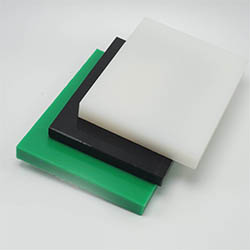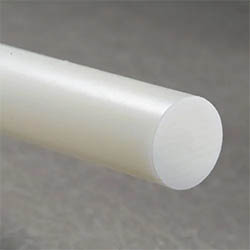HDPE Sheets & Rods
HDPE Sheets

High-Density Polyethylene (HDPE) sheets are a versatile and widely-used thermoplastic material known for their exceptional durability and chemical resistance. These sheets are manufactured from HDPE resin through a heat and pressure process, resulting in a sturdy, opaque material with excellent mechanical properties. They are used in diverse applications, including water and chemical storage tanks, playground equipment, cutting boards, and more, thanks to their resistance to moisture, chemicals, and UV rays. HDPE sheets are also environmentally friendly and recyclable. Their ease of fabrication through cutting, welding, and thermoforming makes them a preferred choice for various industrial, construction, and DIY projects, offering reliability and longevity.
HDPE Rods

High-Density Polyethylene (HDPE) rods are solid cylindrical structures made from HDPE, a robust thermoplastic material with a wide range of applications. Known for their exceptional durability, chemical resistance, and lightweight nature, HDPE rods are favored in various industries. They excel in applications where moisture, corrosion, and chemical resistance are essential, such as water treatment plants, chemical processing, and marine environments. HDPE rods offer excellent electrical insulation properties, making them suitable for electrical and telecommunications applications. Their ease of machining, such as cutting, drilling, and welding, allows for customization and adaptability in numerous industrial and DIY projects. These rods provide a cost-effective and reliable solution for diverse needs.
Technical Property Chart
|
TYPICAL PROPERTIES of POLYETHYLENE |
||||
|
ASTM or UL test |
Property |
LDPE |
HDPE |
UHMW |
|
PHYSICAL |
||||
|
D792 |
Density (lb/in³) (g/cm³) |
0.033 0.92 |
0.035 0.96 |
0.034 0.93 |
|
D570 |
Water Absorption, 24 hrs (%) |
<0.01 |
<0.01 |
<0.01 |
|
MECHANICAL |
||||
|
D638 |
Tensile Strength (psi) at 72°F |
1,400 |
4,600 |
5,800 |
|
D638 |
Tensile Strength (psi) at 150°F |
400 |
400 |
400 |
|
D638 |
Tensile Modulus (psi) |
57,000 |
200,000 |
80,000 |
|
D638 |
Tensile Elongation at Break (%) |
100 |
400 |
300 |
|
D790 |
Flexural Strength at Yield (psi) |
1,500 |
4,600 |
3,500 |
|
D790 |
Flexural Modulus (psi) |
29,000 |
174,000 |
88,000 |
|
D695 |
Compressive Strength (psi) |
1,400 |
4,600 |
3,000 |
|
D695 |
Compressive Modulus (psi) |
54,000 |
100,000 |
80,000 |
|
D732 |
Shear Strength (psi) |
- |
- |
3,000 |
|
D785 |
Hardness, Shore D |
D45 |
D69 |
D62-D66 |
|
D256 |
IZOD Notched Impact (ft-lb/in) |
No Break |
1.3 |
No Break |
|
THERMAL |
||||
|
D696 |
Coefficient of Linear Thermal Expansion (x 10-5 in./in./°F) |
- |
6 |
11 |
|
D648 |
Heat Deflection Temp (°F / °C) at 66 psi at 264 psi |
120 / 48 116 / 46 |
170 / 76 176 / 80 |
203 / 95 180 / 82 |
|
D3418 |
Approx. Melting Temperature (°F / °C) |
244 / 118 |
260 / 125 |
275 / 136 |
|
- |
Max Operating Temp (°F / °C) |
160 / 71 |
180 / 82 |
180 / 82 |
|
C177 |
Thermal Conductivity (BTU-in/ft²-hr-°F) (x 10-4 cal/cm-sec-°C) |
- - |
- - |
2.84 10.0 |
|
UL94 |
Flammability Rating |
HB |
HB< |
HB |
|
ELECTRICAL |
||||
|
D149 |
Dielectric Strength (V/mil) short time, 1/8" thick |
460-700 |
450-500 |
2300 |
|
D150 |
Dielectric Constant at 1 MHz |
2.25- 2.30 |
2.30- 2.35 |
2.30- 2.35 |
|
D150 |
Dissipation Factor at 1 kHz |
0.0002 |
0.0002 |
0.0005 |
|
D257 |
Surface Resistivity (ohm/square) at 50% RH |
> 1015 |
> 1015 |
> 1015 |
|
D495 |
Arc Resistance (sec) |
135-160 |
200-250 |
250-350 |